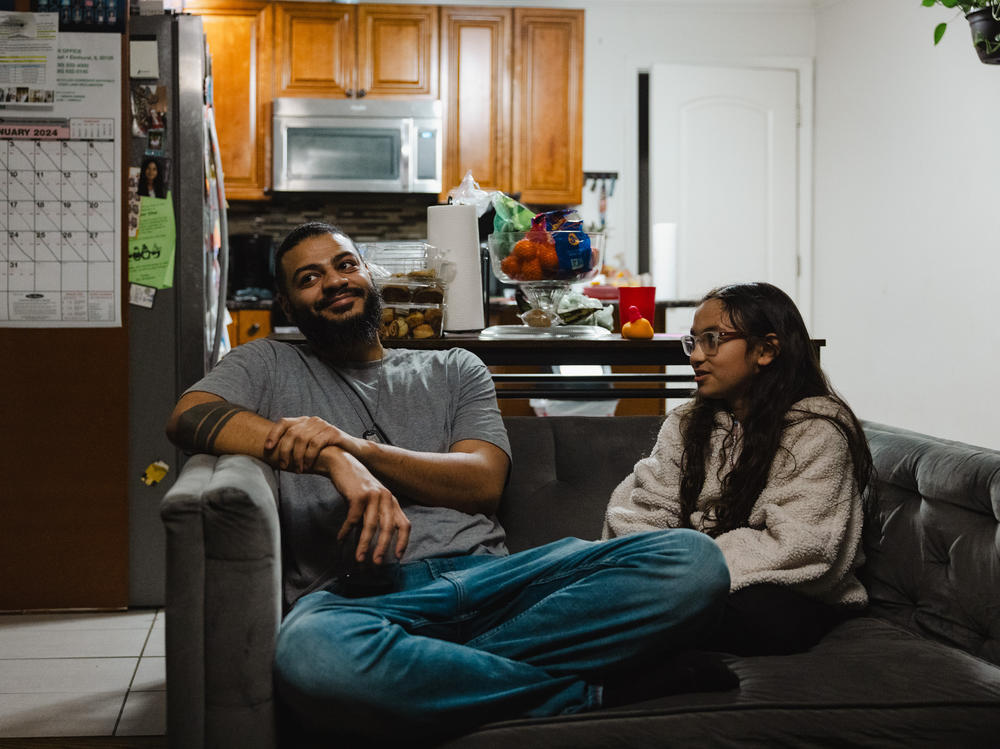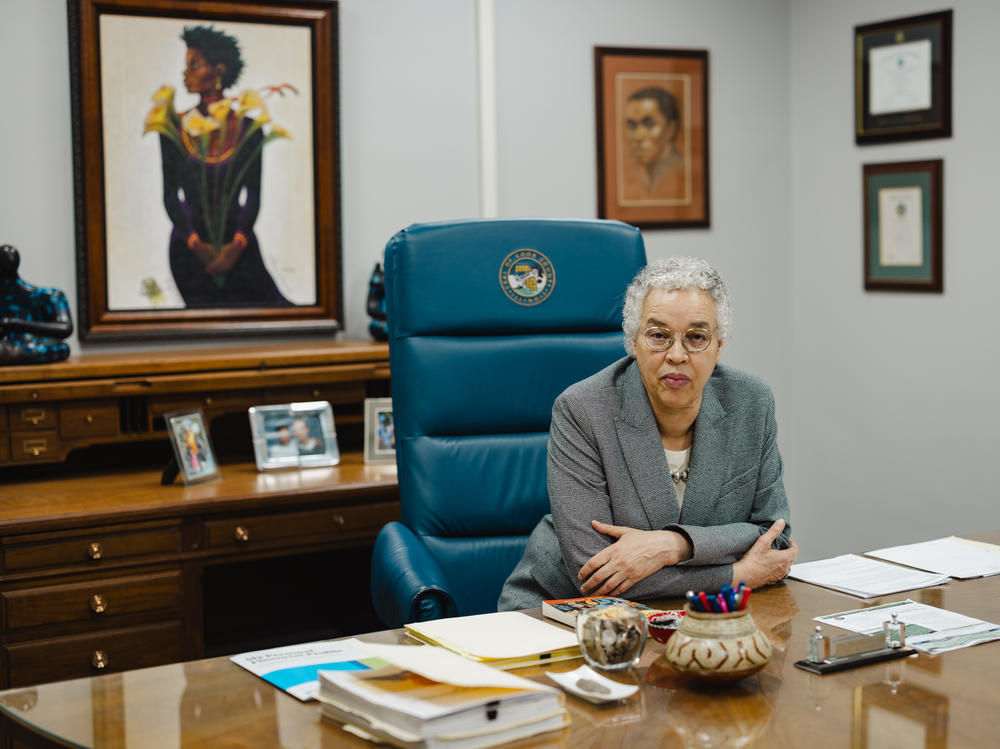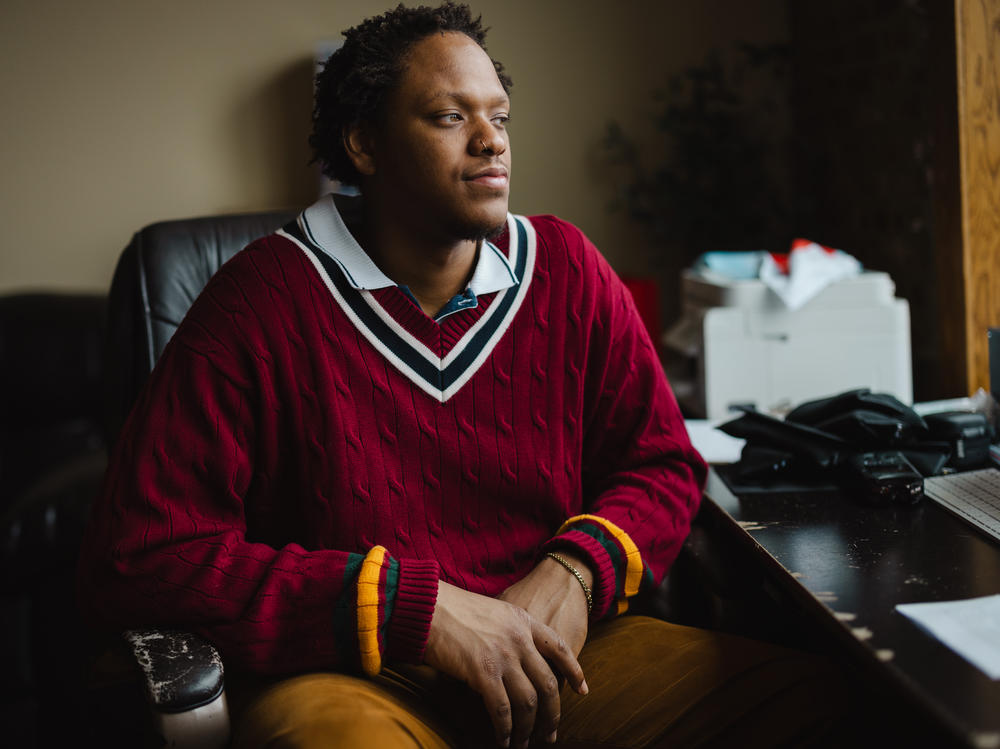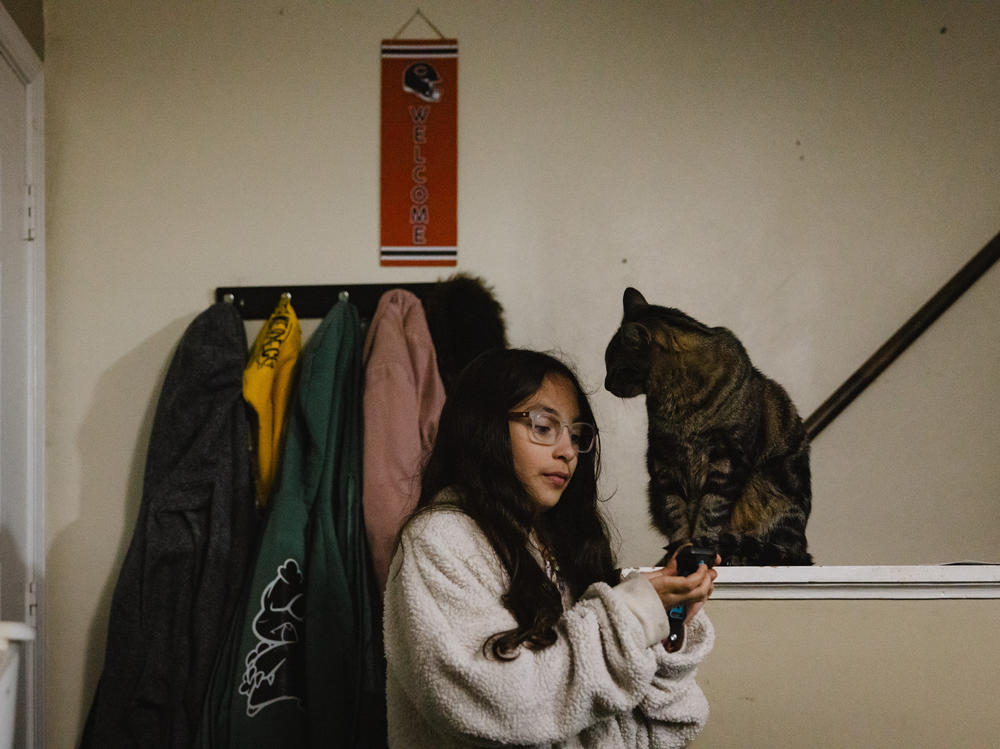Section Branding
Header Content
Places across the U.S. are testing no-strings cash as part of the social safety net
Primary Content
Christopher Santiago recalls being skeptical the first time he heard about basic income — giving people cash with no conditions on how to spend it. It was 2020, when presidential candidate Andrew Yang pitched it for all American adults, and Santiago thought, "That doesn't make much sense."
But for a year now, Santiago has been getting $500 a month through one of the largest cash aid pilots in the U.S., and he's come around.
The single dad of three lives in Alsip, Ill., and was one of a whopping 233,000 people who applied for the program in Cook County, which includes Chicago. (There was a lottery to pick the 3,250 participants.) As a public employee, his income is toward the upper end of the program cutoff, but he says it hardly feels like enough for a family of four.
Snuggling on the couch next to his youngest daughter, 9-year-old Calliope, he says the extra cash has helped him manage skyrocketing prices for everything. And it's let him provide more for his children, including ballet classes, a birthday visit to Disney on Ice, and family trips.
"It's a hard thing to have to tell a child, 'No,' " he says. "It kind of kills you a little bit."
Santiago was also able to avoid a mini-emergency when right after a weekend trip, his furnace broke. "It was a $700 part and I was just like, 'Oh God, this would have sunk me.' "
A once radical idea got a boost during the pandemic
Cash aid without conditions was considered a radical idea before the pandemic. But early results from a program in Stockton, Calif., showed promise. Then interest exploded after it became clear how much COVID stimulus checks and emergency rental payments had helped people. The U.S. Census Bureau found that an expanded child tax credit cut child poverty in half. That is, until the expansion ended and child poverty spiked.
Around the country, from big cities to rural counties, there've been more than 150 basic income pilots, and counting. Supporters say it works because people can spend the money on whatever they need most.
"They can pursue education for themselves and their children," says Toni Preckwinkle, president of the Cook County Board of Commissioners. "They can invest in their families in ways that makes them more productive and more stable over time."
The idea is not new. Preckwinkle notes that the Rev. Martin Luther King Jr. and the Black Panthers called for guaranteed income. So, briefly, did President Richard Nixon. These days, some tech entrepreneurs argue that cash aid will be needed as gig work, automation and AI threaten jobs.
Preckwinkle thinks cash aid should be a permanent part of the social safety net. And she wants to prove it works, so it could someday go nationwide.
"The federal government is really the only entity that has the resources to do this on the mass scale that it needs to be done," she says.
As pandemic money runs out, basic income programs might sputter
The pandemic also spurred cash aid because cities got their own pot of COVID relief money. Many are using that to fund guaranteed income pilots. Philanthropic donations are another major funding source, including from groups that have long organized direct cash payments to combat poverty in developing nations.
The pilots target low- to moderate-income people, from a few hundred to a few thousand households, and generally pay them $500 or $1,000 a month for a year or two.
When Cook County's two-year pilot ends, Preckwinkle has vowed to use the county's own budget to keep it going. A few states have also allocated funding to cash aid programs. But as pandemic money runs out, it's possible this mass experiment could fizzle.
"That's a concern, and that's what we are pushing back against," says Natalie Foster, president of the Economic Security Project, which advocates for guaranteed income. She founded the group along with Chris Hughes, a co-founder of Facebook.
Foster says the U.S. has more poverty than almost any other rich nation and that its social safety net is one of the stingiest.
"If you look at so many other countries with similar economies, you understand that college is free," Foster says. "They ensure that health care is cheap and affordable. Oftentimes, child care is free. That is the type of life we could offer Americans and choose not to."
The problem hit home for Ameya Pawar with a trip to his local pharmacy. He's now a senior adviser with the Economic Security Project in Chicago. But in 2016, he was a new dad who was sent to get diapers and was puzzled to find them and other baby products under lock and key.
He came to realize that people are not allowed to use public assistance to buy diapers or wipes, and saw the locks as a heartbreaking sign of their desperation. Because "you need to send your infant with diapers or wipes to attend child care, so you can go to work," he says.
Pawar and others point to welfare reform in the 1990s, which dramatically reduced the amount of cash assistance. For the poorest families, that lack of cash can make it hard to pay for things like utilities, transportation to a job, enough food for a full month or school supplies for children.
This is partly why advocates for basic income say it's not meant to replace other assistance, but to add to it.
An extra $500 a month may still not be enough to get ahead
TaylorRaquel Adams says the $500 she gets each month from the Cook County pilot is a blessing, even if she's "still in poverty."
She works an overnight shift at an Amazon plant — 3:30 a.m. to 8:30 a.m. — in the department where things get returned. "I'm inspecting it to see if we can resell it, if it needs to be refurbished, or if it's salvage," she says.
Adams is 42, single and has no children. She's worked since she was 15 and would love to work full time again. But she says it would be tough, given that she suffers PTSD from childhood trauma and has schizoaffective disorder.
Adams gets disability income, a housing subsidy and food aid. And still, despite her conscientious budgeting, the extra cash basically helps her make ends meet. "I'm hoping in the next couple of months I get some savings," she says.
Much of the money has gone for medical expenses. Adams' Medicare plan does not cover dental or vision, and she needs to spend $500 more a month for that. Two years ago, she was diagnosed with ulcerative colitis, and the supplements and vitamins her doctor recommends can mean spending hundreds of dollars some months.
The cash aid also let her buy Christmas presents last year for the first time in a while. And it allowed her to splurge on a pedicure for her birthday — what she calls "pamper-me time." One month's payment went for a pricey repair on her Chevy Spark, an enormous help given her nearly hourlong commute to Amazon.
"You need income to work," she says. "There's only so many jobs in my area that's within walking distance."
For Matt Harvey, the extra monthly income has made it far easier for him to work full time.
Harvey is 25 and was unemployed when he applied for Cook County's basic income pilot. He and his girlfriend lived separately at the time, but he did most of the parenting for their toddler son while she worked.
After they moved in together, they used the extra money for groceries and household items. Harvey says the payments lowered his stress and made him "feel more like I'm contributing."
He tried to ramp up side gigs as a driver for Uber and Amazon Flex. But he says it was always a calculation over whether the money he made from those hours was worth the cost of day care, "because the day care is expensive."
Then Harvey got a full-time job in research and communications at a nonprofit. It meant his son would have to be in child care full time at a cost that felt out of reach: $2,000 a month.
"We were only able to put him in day care because of the extra $500," he says.
Their rent is going up again this year. And though Harvey didn't finish college, he still owes about $20,000 in student debt. Still, he feels they're in better shape with his new job. And they're planning ahead so they can be prepared for when the extra monthly payments stop.
Cash aid can also help people's psychological well-being
Guaranteed income programs specifically do not require people to work. That's a selling point for supporters, who say the extra cash can create the time and space to find a better job or perhaps a new direction.
But the lack of any work requirement is a main concern for opponents, especially if no-strings cash aid were to be made permanent.
"My fear is that we would see earnings and hours and work decrease amongst low income Americans," says Leslie Ford, with the conservative American Enterprise Institute.
She agrees the U.S. social safety net needs to change but says work should remain at the heart of it.
"Ultimately, if we want this person to become self-sufficient, if we want the outcome of our safety net to not merely be subsistence, work is a key aspect of flourishing long term," Ford says.
So far, with one- to two-year cash aid pilots, researchers say there's been no significant impact on whether people have jobs. Some parents, though, have cut back on gig work to spend more time with their children.
Researchers also reject the stigma that poor people can't be trusted with free money.
"They spend the money in ways that everyone does," says Stacia West with the University of Tennessee, and a co-founder of the University of Pennsylvania's Center for Guaranteed Income Research. "Going to the grocery store, making sure the rent is paid, paying the car note."
She and her co-researcher Amy Castro have published peer-reviewed research on several cash aid pilots, including in Stockton, Calif., and are following others around the country. They find that — no surprise — the extra income makes people more financially stable. After about six months of payments, they also start to see "little glimmers of changes in a person's psychology," says West. "We see increases in a person's psychological well-being, so a reduction in psychological distress."
They also find the changes fade within months after the money stops, as more households report they would not have $400 for an emergency.
Castro says public momentum on basic income is moving faster than the data, and there are still many open questions.
"How long do people need to be receiving cash in order to create change? And how do we put that into policy in such a way that it actually makes sense?" she asks. "These programs are expensive. People should be asking those questions."
Castro, West and others are racing to find answers, as more and more places turn to direct cash payments to help struggling Americans.





